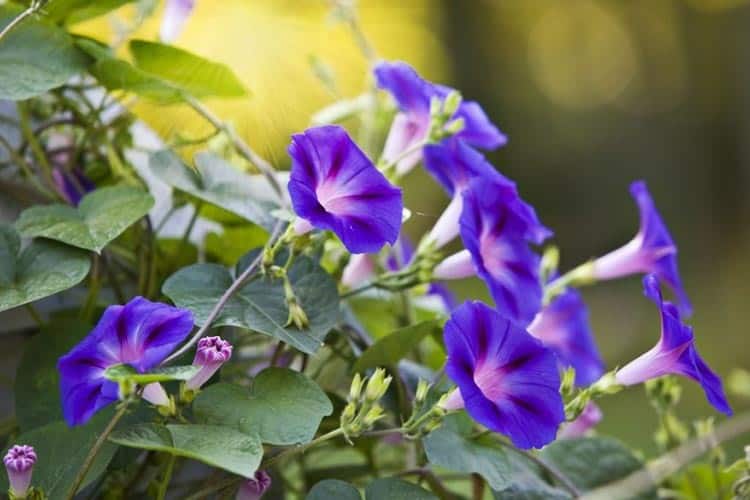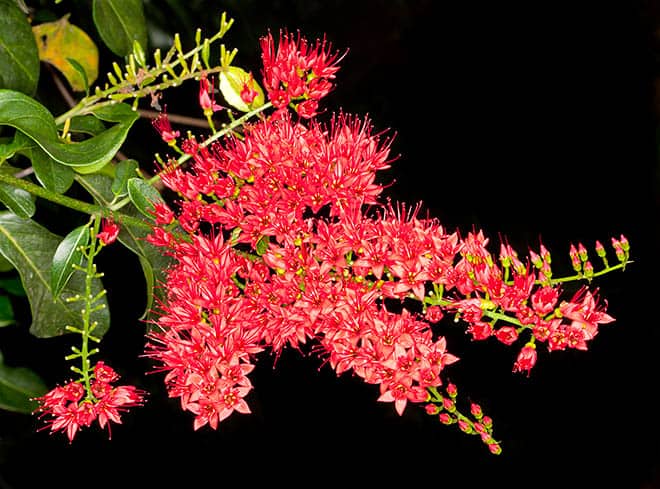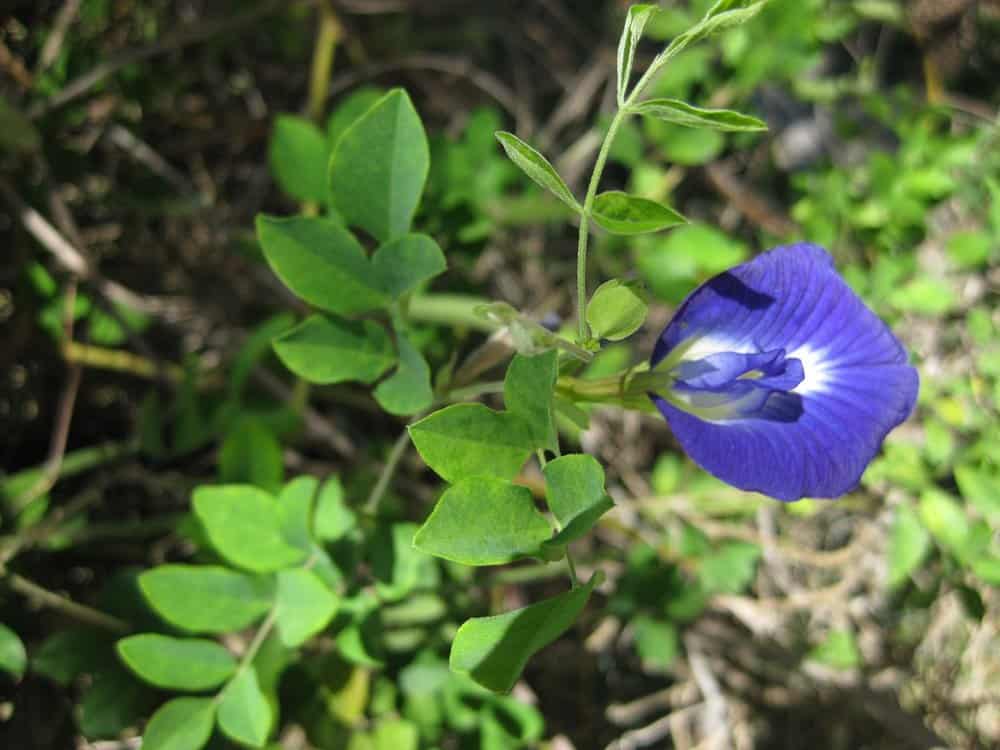Before we get started, let’s understand what the term “creeper” really means. Also called procumbent, meaning they grow with their stems trailing along the ground without rooting. Creepers are any type of plants that are small in size and grow along the ground.
However, in some cases, they tend to grow longer than they normally do, and in such cases, gardeners may wish to have them grow up a structure or support. For these purposes, the creepers need to be nourished with care, as with all plants; gardening at its true core is “parenting” your plants.
Here is a list of 8 best creepers that you can grow with just a little care and proper nourishment. This list has been curated with a lot of research to find the best ones that suit a nicely developed garden. This list can also be adopted if you’re just venturing into gardening and need a nice addition to add to your beautiful garden.
Contents
1) IPOMOEA NIL:
There are many different names for this like Japanese morning glory, picotee morning glory. Nearly thousands of varieties of ipomoea nil can be found on the internet. The family name is Convolvulaceae (don’t worry if you didn’t get it right the first time). Their average height is about 2 to 3 meters long. They appear in colors like blue, rose or pink.

First discovered from China, some resources claim to believe it originated from Korea. They are most popular in Japan as people over there love it so much that they would keep glory markets and sell them differently.
Growing tips:
Moderate fertilization is very important for these plants. Keep the soil well-drained and moist.
Remember that these plants need direct sunlight.
The seeds need to be soaked in water for about a day at room temperature before sowing.
Benefits:
The seeds possess laxatives and antifungal and antispasmodic pigments. Diseases like constipation and edema (excessive fluid formation in the body) can be cured using these plants.
2) Thunbergia alata:
This is also known as the “Black-eyed Susan” creeper plant. The family name is Acanthaceae. Native to the Eastern parts of Africa, these plants grow to a height of 6-8 feet and are mostly found in tropical zones. The leaves form the shape of a heart bearing five beautiful petals. They appear in orange color with a black spot in the center. They are also available in red, white and yellow. These are mostly used as ornamental plants owing to their beautiful color and appearance. Their delightful fragrance makes them beautiful presents.

The creeper plant gets its name from a character resembling the beautiful Susan from the story of John Gay, which inspired the people to keep that name.
Growing tips:
The seeds must be soaked in warm water to remove the germs and kept for a night.
Since this creeper plant can grow fast while also blooming, it is recommended to have light trimming for more blossoms.
Benefits:
The root of this plant is used to treat various diseases like Rheumatic Arthralgia ( joint pains ) and fractures as well.
3) COMBRETUM COCCINEUM:
This creeper plant is also called the “flame” creeper plant or scarlet comb. The name comes from the family Combretaceae. The plant is believed to have originated from Madagascar. The beauty of this creeper plant is it adapts to the climate and is a shrub meaning that it is evergreen producing scrambling stems.

This creeper plant is mainly used not only as an ornamental but sometimes also as a hedge. The plant’s color is a bright red which explains the name “flame creeper”. This creeper plant can be kept and just admired on your balcony for its beautiful color. These creeper plants are mostly tropical. These are habitats of evergreen climber.
Growing tips:
The plant requires partial to full sunlight.
The water requirements are moderate (Be sure to check out ElitechDrip to get your water irrigation kits).
The temperature is recommended to be below 35 degrees (Celsius). It grows mostly during the spring and summer seasons.
Benefits:
They have huge medicinal uses like getting the digestive tract rid of parasites.
They can also be used to cure diseases. These are also used to make fiber.
4) CLITORIA TERNATEA:
These creeper plants have many names like Asian pigeonwings, Bluebell creeper plants, blue pea, butterfly pea, and Darwin pea. It belongs to the family Fabaceae. This was named after the resemblance vulva of the human.

This plant was named by Rump, a German who was an expert botanist. Many botanists have come up with different names for this plant over the years since its discovery, but only the name “Clitoria” has survived up to this date.
The history of the clitoria is pretty amazing, but what also dazzles many is the beauty of this plant. Clitoria is of the glorious blue color, making the creeper plant an absolute spectacle. These are mostly found in North America and parts eastern to Australia. In India it’s commonly known as Aparajita.
Growing tips:
These are the easiest plants to grow, and in Hinduism, devotees believe that the plant holds auspicious value because it is most liked by Lord Shiva. They are mostly found on Continentals.
Benefits:
They are used as herbal medicines for various diseases and are also used for cooking. Its roots are used in Ayurvedic treatment.
5) PASSIFLORA INCARNATA:
This creeper plant is also called a passionflower. They are found in different colors like red-
purple and have around five hundred different species among them. These are wild creeper plants having the ability to grow at a rapid rate.

These species were divided into twenty-two different classes in 1938. Its family name is Passifloraceae. These creeper plants are tendril-bearing or found to be trees or shrubs. The plant can ripen into a fruit which then contains numerous seeds. These creeper plants are mostly pollinated by bumblebees, bats, and many more.
An important fact about the passiflora is that they were used in the discovery of coevolution theory. This creeper plant is rich in organic acids and is sometimes considered poisonous. Chrysin is the chemical compound found in this creeper plant.
Growing tips:
As they have the ability to grow fast, the process is simple: It just needs to be watered on a regular basis.
Proper sunlight is key to getting a good growth on this plant.
Benefits:
They are mostly used as ornamental fruits and found in the tropical regions.
Passiflora plants are mainly used as hybridizing and are found successful in this process.
6) CLERODENDRUM THOMSONIAE:
These are more often called the “Bleeding Heart” creeper plant. The family name is Lamiaceae. The flowers consist of white petals and red tiny petals in the middle, hence the name. These are native to tropical West Africa.

The plant can reach a height of four meters. With leaves of 8-17 cm long, this beautiful flower is a visual delight and a treat to the eyes.
They have around 400 species and these in some regions are naturalized rather than cultivated due to their appearance. It was known as “Beauty Bush” in the early 19th century, by a missionary in Nigeria who happened to also be a physician. The man named this flower in the memory of his late wife.
Growing tips:
These plants require that their roots are partially submerged in water most of the time. They are sure to be dehydrated this way.
The plant also needs good light, so planting these seeds in a bright region of the garden is essential for its growth.
Benefits:
These creeper plants are used as ornamental plants and for some medicinal purposes.
Because of their beauty, they are sold at high rates so if you’re in it for the money, this is a gold mine.
7) GALPHIMIA GRACILIS:
These are often called “slender gold shower” as they come in bunches, and create the effect of a gold shower owing to their beautiful yellow petals. They are mostly found in Mexico and cultivated in warm regions. They also have other names like thryallis glauca which are often misunderstood as galphimia glauca. The family name is Malpighiaceae.

The petals of these creeper plants are 8-14 mm long and 4-8 mm wide. These have pollens that are spherical, approximately 16-18 microns in diameter. These creepers have a lush green color to their leaves which makes them more attractive. These creepers are easy to be found.
Growing tips:
In these creepers, the seeds are to be sown and have to be injected through the sandy soil.
Placed four to five feet apart in-ground, the soil has to be enriched through compost. Watering the creeper regularly and also fertilizing it can improve results.
Benefits:
They are used to treat asthma and different allergies.
They are also used by pregnant ladies to aid breastfeeding. They are mostly used for homeopathic treatment.
These plants are also prescribed in the treatment of anxiety and depression, and also in the treatment of eye diseases and itching.
8) MANDEVILLA SPLENDENS:
These are also called Dipladenia splendens. The family is Apocynaceae. This creeper which is a lookalike of a rose has its native in Brazil. The interesting thing about this is that it climbs by twining.

The maximum height of the Mandevilla is around three meters. The leaves are wide elliptical or rectangular in shape. The color of this creeper is rose-pink and the center section having yellow in color. This creeper takes a time span of around 5 to 10 years to reach its maximum height. In summer this creeper produces 3 to 5 sprays of 5 funnel-shaped. The plant spreads around 1 to 1.5 meters in its prime.
Growing tips:
This creeper requires a warm temperature and direct light.
The seeds have to be semi-ripe while sowing in summer with bottom-heat.
The moisture should be adequate and also well-drained.
It is a general practice that the plant is faced towards the west or east to get a proper amount of sunlight.
Benefits:
They are mostly used as ornamental plants due to their rapid growth rate.
They can be used as a decorative ornament too. Research on these creeper plants is still an ongoing project since its maximum beneficial value is yet to be determined.
You’ll like this video on Creepers for container gardening:
An important fact about creeper plants is that they have a weakness in their stem. This is why they cannot grow erect on their own and tend to find support.
From the base of their stems, they have the ability to produce roots that are similar to fiber. This helps them to get fixed and grow further.
Well, those were the Top 8 creeper plants that you can grow in containers. If you liked the article, then you are bound to enjoy similar articles on our blog here.
Creeper plants have a ton of benefits as well. Growing creepers in your garden help improve the overall atmosphere, reduces the level of stress, and also decreases background noise. They have a great quality of improving the overall sense of well-being of the garden. Learn What are the Best Climbers Plants
Head over to ElitechDrip to get your own Drip irrigation kits for your gardens, and never worry about watering your plants ever again.

